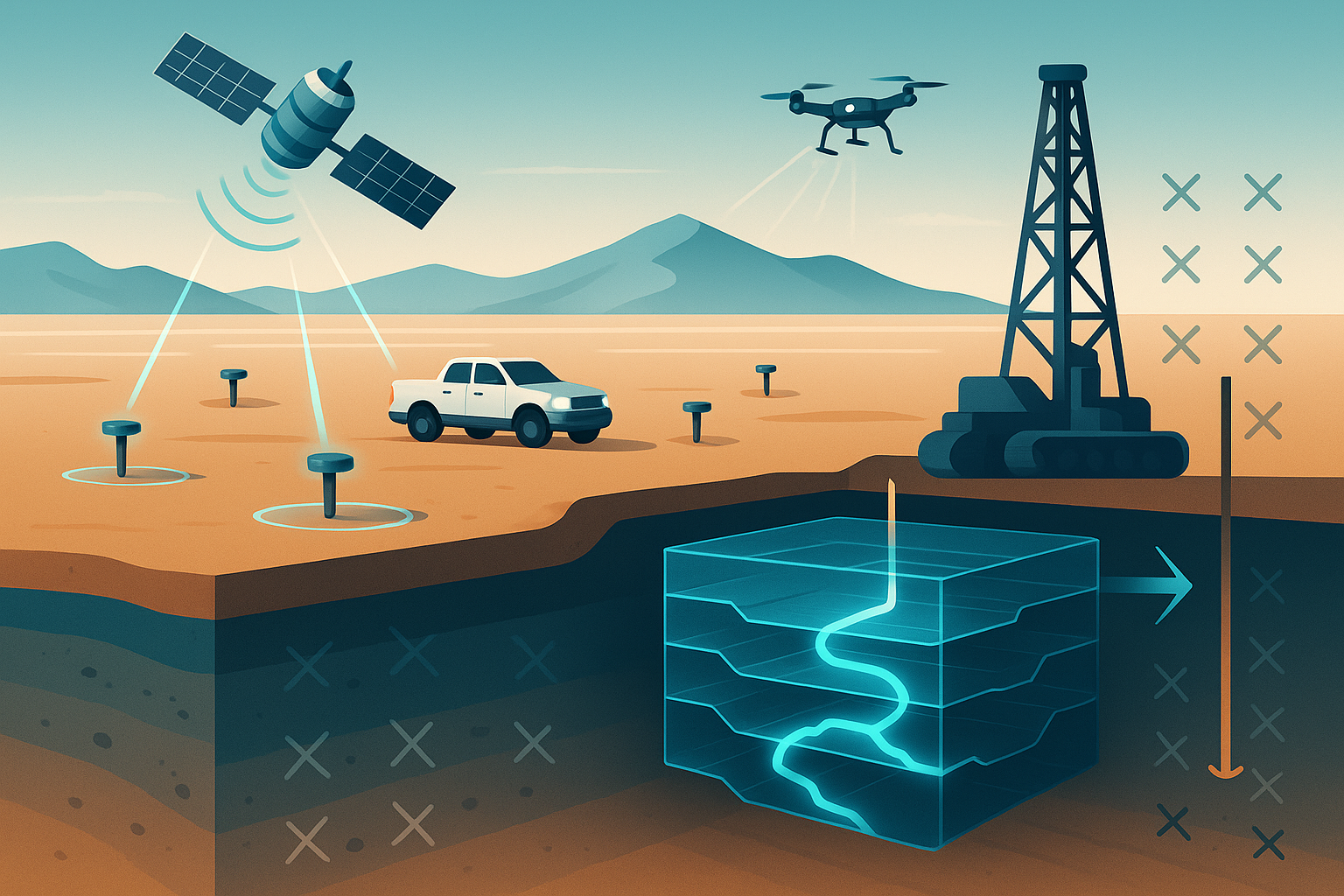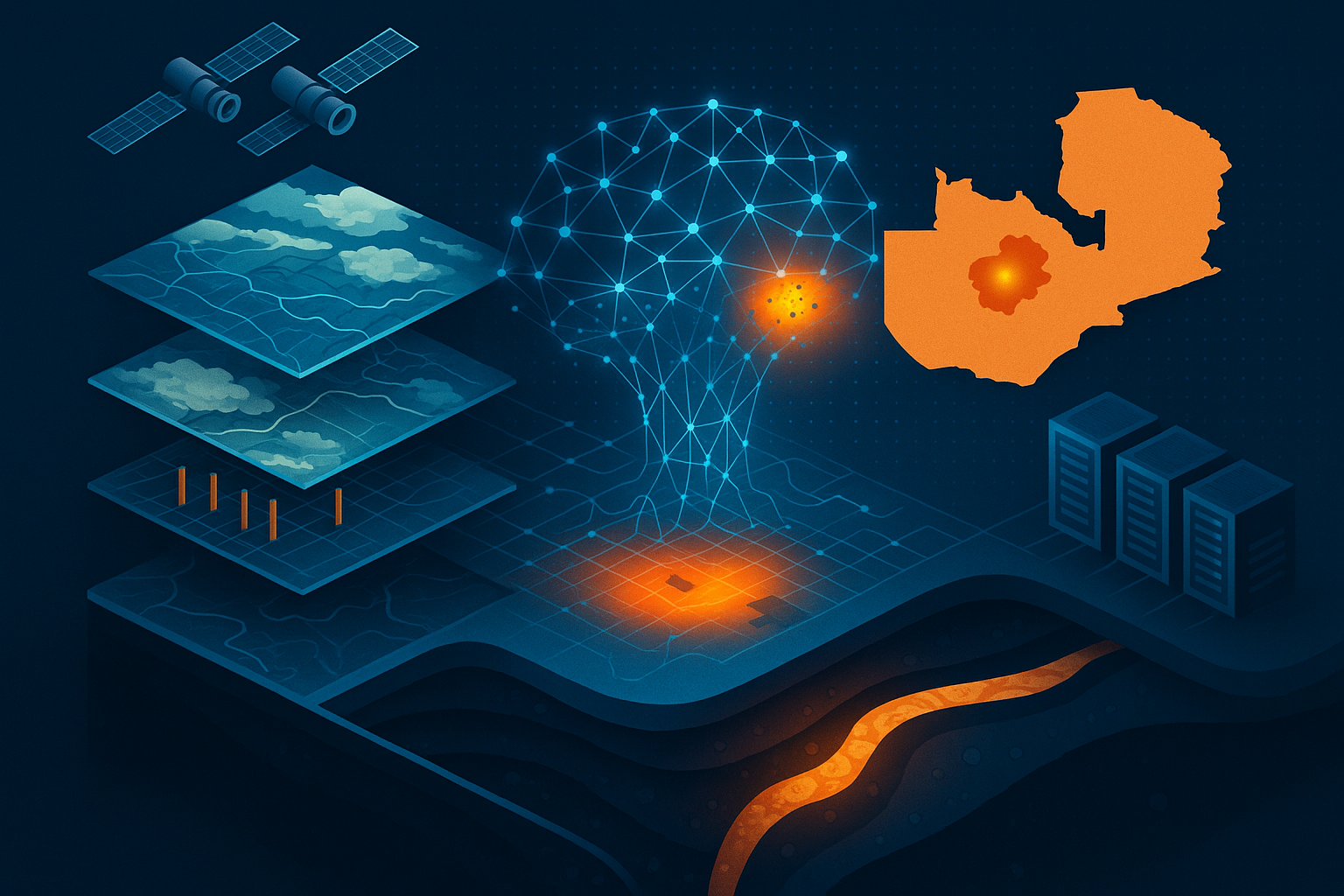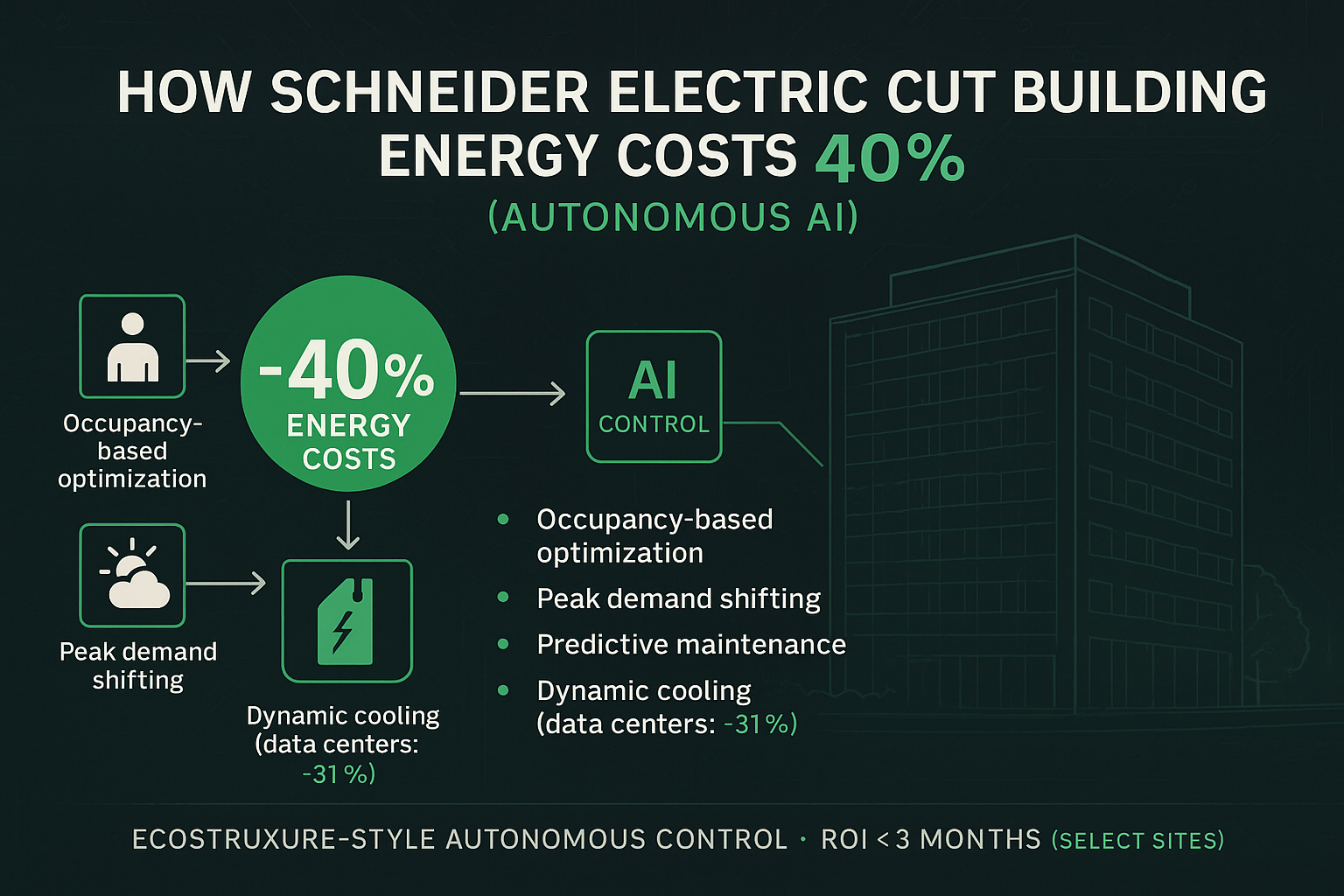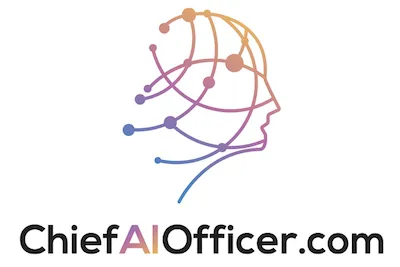Traditional mineral exploration works like this: geologists study surface geology, make educated guesses about where valuable minerals might exist underground, drill exploratory holes, analyze core samples, then repeat. Each drill hole costs $50,000-200,000 and provides data from a tiny point in three-dimensional space. Finding economically viable deposits requires drilling dozens or hundreds of holes based on incremental learning from previous attempts.
Rio Tinto’s AI-powered exploration at their Rincon lithium project identifies drill targets up to 100 times faster than traditional methods. Not by drilling more holes. By using AI to create 3D subsurface maps from non-invasive sensor data, eliminating most exploratory drilling before accurately targeting the specific locations most likely to contain economically viable mineral concentrations.
The competitive advantage isn’t just speed. It’s economics and environmental impact. Reducing exploratory drilling by 90% while increasing discovery accuracy creates cost savings measured in millions per project while dramatically reducing environmental disturbance from exploration activities. This matters increasingly as mining faces growing pressure to minimize environmental footprint.
The Exploration Economics Problem
Mineral exploration represents one of the highest-risk investments in natural resources. Companies spend hundreds of millions exploring properties where most drilling finds either no economically viable minerals or deposits too small to justify development. A successful discovery that leads to production might require exploring 100 properties to find one that works.
The traditional exploration workflow hasn’t fundamentally changed in 70 years despite dramatic technological advances in other areas. Geologists use improved analytical tools and better geological models, but the core process remains: make educated guesses, drill holes, analyze results, refine the model, drill more holes.
Each iteration takes weeks or months. Drill rigs must mobilize to remote locations, often requiring road construction or helicopter support in mountainous terrain. Drilling through hundreds of meters of rock takes days per hole. Core samples get shipped to laboratories for detailed analysis taking additional weeks. By the time results come back, seasons might have changed, making additional drilling impossible until next year.
The cost structure makes exploration economically challenging even for major mining companies. A regional exploration program might budget $5-10 million for an exploration season, drilling perhaps 30-50 holes across a large property. If those holes don’t find economically viable mineralization, the entire investment is lost. The exploration team must decide whether to abandon the property or commit additional millions for another exploration phase.
The risk-reward math forces conservative exploration strategies focused on geological settings similar to known deposits. Truly novel deposit types or unusual geological environments get under-explored because the cost of failure is too high. This systematic bias toward exploring “near known deposits” means the industry likely misses significant mineral resources in geological settings that don’t match established patterns.
Rio Tinto’s AI-powered approach changes these economics fundamentally by dramatically reducing the exploration drilling required to assess a property. When you can map subsurface geology accurately without drilling, the cost and timeline of exploration decrease by an order of magnitude, enabling more aggressive exploration of properties that traditional methods couldn’t economically evaluate.
The 3D Subsurface Mapping Revolution
Rio Tinto partnered with Fleet Space Technologies to deploy AI-powered geophysical imaging that creates detailed 3D maps of subsurface geology without drilling. The system uses networks of sensors that measure variations in Earth’s electromagnetic properties, which differ based on rock type, mineralization, and geological structures.
Traditional geophysical surveys collected similar data but generated results requiring expert interpretation and provided limited resolution at depths where valuable minerals exist. The raw sensor data contains far more information than traditional analysis techniques could extract because the complexity exceeds what human geologists could manually interpret.
AI models trained on thousands of previous surveys learn to recognize patterns in geophysical data that indicate specific geological features: faults that might concentrate mineralization, rock types associated with valuable deposits, or structural features that guided mineralizing fluids millions of years ago. The models don’t just process data faster than humans. They identify subtle patterns that human interpretation would miss entirely.
At the Rincon lithium project, this approach identifies specific drilling targets with confidence levels high enough to justify expensive drilling based primarily on AI interpretation of geophysical data. Traditional approaches would require extensive drilling to build similar confidence about where economically viable lithium concentrations exist.
The practical workflow becomes: deploy sensor networks across the property, collect geophysical data, run AI models to generate 3D subsurface maps highlighting probable drill targets, then drill only the highest-probability locations identified by AI analysis. Instead of 50 exploratory holes spread across the property learning incrementally, perhaps 5 precisely targeted holes confirm what AI mapping already suggested.
The 100x Speed Improvement Reality
The claim of finding drill targets “up to 100 times faster” deserves detailed examination because it sounds almost too good to be true. The speed improvement comes from several sources that multiply together.
Data Collection Speed: Traditional drilling might take 3-4 weeks to complete and analyze each hole. Geophysical sensor networks collect data continuously across large areas simultaneously. A network deployed over a few days generates subsurface information equivalent to what would require months of drilling.
Coverage Density: Drilling provides detailed information from discrete points spaced hundreds of meters apart. Geophysical data provides continuous coverage, revealing geological features between drill holes that traditional methods would miss.
Iteration Cycles: Traditional exploration requires completing one drill phase, analyzing results, planning the next phase, and waiting for appropriate season/conditions to drill again. AI analysis of geophysical data happens in days or weeks, enabling rapid iteration and refinement.
Decision Confidence: Traditional methods require extensive drilling before geologists feel confident they understand deposit geometry and quality. AI-generated 3D models provide high confidence from initial data, enabling faster go/no-go decisions about property potential.
The compounding effect of these improvements creates the 100x headline number. What might take 18-24 months through traditional drilling campaigns (multiple field seasons) might take 2-3 months with AI-powered geophysical mapping. That’s 6-12x faster. Factor in better targeting that eliminates wasted drilling, and the effective speed improvement for identifying economic drill targets reaches the claimed 100x.
The speed advantage matters beyond just faster discovery. It reduces capital requirements for exploration because companies can evaluate more properties with the same budget. It enables exploring properties in remote or environmentally sensitive areas where minimizing ground disturbance is critical. And it allows faster response to commodity price changes that affect which mineral deposits are economically viable to develop.
The Autonomous Operations Ecosystem
Rio Tinto operates one of the world’s largest autonomous vehicle fleets: over 400 autonomous trucks, plus autonomous drills and AutoHaul™ trains, all coordinated through Remote Operations Centres located thousands of kilometers from actual mining sites.
The scale of autonomous operation matters because it creates network effects where the value increases with fleet size. Each autonomous truck generates operational data that helps optimize routing, loading, and maintenance for the entire fleet. The system learns from every equipment interaction, continuously improving efficiency across all operations.
Traditional mining operations require haul truck drivers in remote locations working rotating shifts in harsh conditions. Driver fatigue affects safety and productivity. Human error causes accidents. Labor costs represent significant operating expenses. Recruitment and retention of qualified operators in remote locations creates ongoing challenges.
Autonomous trucks eliminate these issues while operating 24/7 without fatigue, breaks, or shift changes. The vehicles follow optimized routes calculated in real-time based on current conditions: road surface quality, traffic patterns from other vehicles, loading efficiency at various shovels, and dump locations. They adjust speeds and routes continuously to maximize productivity while minimizing fuel consumption and equipment wear.
The productivity improvement is substantial. Autonomous trucks achieve 15-20% higher productivity than human-operated fleets through consistent optimal operation without fatigue-related performance degradation. They also demonstrate better safety records because they don’t make judgment errors, get distracted, or take risks to save time.
I’ve observed similar dynamics in logistics automation where autonomous systems improve efficiency not through dramatically faster operation but through perfect consistency and coordination that human operators can’t match. The advantage comes from eliminating variability and optimizing across the entire system rather than optimizing each vehicle independently.
The Predictive Maintenance Transformation
Mining equipment operates in extremely harsh conditions: massive mechanical stresses, abrasive materials, temperature extremes, and continuous operation. Equipment failures cause production shutdowns costing millions per day in lost output plus emergency repair costs at premium rates.
Traditional maintenance approaches use fixed schedules based on operating hours or calendar time, attempting to prevent failures through regular service intervals. This over-maintains some equipment (servicing components still in good condition) while under-maintaining others (allowing components to fail before scheduled maintenance).
Rio Tinto’s AI-powered predictive maintenance analyzes sensor data from thousands of equipment components, learning normal operating patterns and identifying deviations that indicate impending failures. A bearing showing elevated vibration patterns gets flagged for replacement during scheduled maintenance before catastrophic failure occurs. A hydraulic system with gradually increasing operating temperatures suggests seal wear requiring attention.
The system doesn’t just predict failures. It optimizes maintenance scheduling across the entire fleet to minimize production disruption. If three pieces of equipment need maintenance but taking all three offline simultaneously would constrain production, the AI schedules interventions sequentially to maintain operational capacity. If weather forecasts indicate a multi-day rain event that will slow mining operations, the AI can schedule maintenance during that period to minimize impact on productive time.
The economic impact shows up in multiple metrics: reduced unplanned downtime, lower maintenance costs through optimal component replacement timing, extended equipment life through better maintenance quality, and improved production consistency from higher equipment availability.
A haul truck that previously experienced 3-4 unexpected breakdowns annually might operate an entire year without unplanned failures when predictive maintenance catches developing problems early. The avoided downtime, emergency repair costs, and production delays from those prevented failures save hundreds of thousands per vehicle annually across a fleet of 400 trucks.
The Processing Optimization Intelligence
Ore processing represents one of the most technically complex aspects of mining because ore characteristics vary constantly even within a single deposit. The mineral content, grain size, hardness, and chemical composition of ore change hour by hour as mining progresses through different zones of the deposit.
Traditional processing uses fixed parameters based on average expected ore characteristics, accepting that these settings will be suboptimal for material that differs from average. When ore is harder than expected, processing throughput decreases. When mineral content is lower than anticipated, recovery suffers. Operators make manual adjustments based on experience and periodic sample analysis, but these changes lag behind actual conditions.
At Rio Tinto’s Kennecott Copper Mine, AI analyzes real-time sensor data from the processing plant along with geological data about the ore being mined, continuously adjusting processing parameters to optimize for current material characteristics. The system predicts how ore currently being mined will behave in the processing plant and preemptively adjusts equipment settings before that ore arrives.
This real-time optimization increases both throughput and recovery. The plant processes more tons per hour because settings stay optimal for current conditions rather than being configured for average conditions. Recovery rates improve because the system adjusts to extract maximum valuable minerals from each batch of ore rather than using generic processing that works adequately across diverse ores.
The cumulative impact across a major processing operation is measured in millions annually. A 2-3% improvement in recovery rates translates to millions in additional product sales from ore that would otherwise go to waste. A 5% increase in processing throughput means the same capital equipment generates more production without expansion investment.
The Digital Twin Strategic Advantage
Rio Tinto employs digital twins (virtual replicas of physical mines) to model operations and test decisions before implementation in the real world. This capability transforms mine planning and operational optimization from incremental trial-and-error to systematic analysis of alternatives.
A mine planner considering whether to expand a particular mining area can simulate the decision in the digital twin, examining impacts on production scheduling, equipment requirements, processing plant capacity, logistics, and economics. The simulation runs in hours or days rather than requiring years to observe actual outcomes.
The digital twin incorporates vast amounts of data: geological models of mineral deposits, equipment performance characteristics, weather patterns and their impact on operations, maintenance histories, and economic variables like commodity prices and operating costs. Machine learning models trained on historical operations predict how changes will affect future performance.
This predictive capability enables risk reduction through virtual testing. An operational change that seems beneficial might have unintended consequences revealed through simulation: increasing mining in one area might overload processing capacity, or changing haul routes might increase equipment wear faster than anticipated. The digital twin identifies these issues before implementation rather than discovering them through expensive real-world failure.
The strategic value extends beyond individual operational decisions. Digital twins enable whole-mine optimization considering complex interactions between exploration, mining, processing, logistics, maintenance, and markets. Human mine planners can’t simultaneously optimize across all these variables. AI-powered digital twins can identify non-obvious opportunities: shifting mining schedules to align with energy price variations, adjusting processing strategies based on forward market prices, or timing equipment maintenance to coincide with planned production slowdowns.
The Safety Performance Revolution
Mining ranks among the world’s most dangerous industries: heavy equipment operating in challenging terrain, underground operations with collapse risks, explosive materials, and extreme environmental conditions. Traditional safety approaches focused on training, procedures, and protective equipment, accepting that human error and equipment failures would cause periodic accidents.
Rio Tinto’s AI-powered safety initiatives attack risks from multiple angles. Smart wearables monitor equipment operators for dangerous fatigue levels using neural network analysis of brain signals. When the system detects fatigue patterns associated with increased accident risk, it alerts supervisors to remove that operator before incidents occur.
Autonomous equipment eliminates human presence in the most hazardous operations. Workers don’t need to operate haul trucks navigating steep grades in variable conditions or drill rigs positioning near unstable rock faces. The equipment operates without human occupants, eliminating injury risk from vehicle accidents that represent significant causes of mining fatalities.
AI monitoring systems analyze video feeds and sensor data across operations to identify dangerous conditions: workers in hazardous areas without proper equipment, equipment positioned unsafely, or environmental hazards like ground instability or toxic gas accumulation. Real-time alerts enable intervention before incidents occur rather than investigating after accidents happen.
The measurable impact shows in safety statistics. Rio Tinto has achieved significant reductions in injury rates across operations deploying comprehensive AI safety systems. Beyond the moral imperative of protecting workers, safety improvements deliver economic benefits through reduced workers’ compensation costs, lower insurance premiums, less production disruption from accident investigations, and improved employee morale and retention.
The Sustainability Competitive Advantage
Mining faces intense scrutiny regarding environmental impact: land disturbance, water usage, emissions, and long-term site remediation. Companies that can demonstrate superior environmental performance increasingly win regulatory approvals, community acceptance, and investor support compared to peers with worse environmental records.
Rio Tinto’s AI systems optimize water usage, reduce energy consumption, minimize waste, and improve environmental monitoring across operations. Digital twins model environmental impacts of operational decisions before implementation, allowing choices that minimize ecological disturbance while maintaining productivity.
The AI-powered exploration reducing drilling requirements delivers immediate environmental benefits: less land disturbance, reduced fuel consumption from drilling operations, and faster site reclamation because there are fewer drill sites requiring rehabilitation. In sensitive environments, the ability to explore with minimal ground disturbance can mean the difference between project approval and rejection.
Processing optimization reduces waste generation by extracting more valuable minerals from ore, meaning less material goes to tailings storage. Energy optimization reduces both operating costs and carbon emissions. Autonomous vehicles operating on optimized routes consume less fuel than human-driven alternatives.
These environmental improvements increasingly translate to economic advantages beyond direct cost savings. Projects with superior environmental performance get permitted faster, face less community opposition, and attract lower-cost capital from ESG-focused investors. Mining companies competing for development rights in environmentally sensitive areas win based partly on demonstrated environmental capabilities, where AI-enabled optimization provides differentiation.
The Proprietary Data Moat
Rio Tinto’s decade-plus investment in AI and automation has created proprietary datasets that represent significant competitive advantages difficult for others to replicate. Every autonomous vehicle operation, every piece of predictive maintenance data, every processing optimization, and every geological survey feeds into databases that make their AI systems increasingly effective.
This data advantage compounds over time. Competitors starting similar initiatives today face the challenge that their AI systems lack the training data Rio Tinto accumulated through years of operations. Even using identical AI technologies, newcomers’ systems will be less effective because they’re trained on smaller, less diverse datasets.
The infrastructure investment required to generate this data represents another barrier. Rio Tinto built Remote Operations Centres, deployed sensor networks across global operations, developed data integration systems connecting diverse equipment and processes, and created the organizational expertise to leverage this infrastructure. Competitors must make similar investments to catch up, requiring hundreds of millions in capital and years of implementation time.
The talent advantage also matters. Rio Tinto has developed organizational expertise in AI deployment at industrial scale that competitors are still building. Their teams understand how to implement AI in harsh operational environments, manage the change management required for workforce adoption, and integrate AI systems with legacy equipment and processes. This accumulated knowledge represents intellectual capital that can’t be easily bought or replicated.
The AutoHaul™ Rail Innovation
Rio Tinto’s autonomous rail system transports iron ore from inland mines to port facilities, operating trains over 280 kilometers with no drivers. This represents one of the world’s longest autonomous heavy-haul rail operations and demonstrates AI capabilities beyond the mine site itself.
The system coordinates multiple autonomous trains sharing the same rail network, optimizing schedules to maximize throughput while managing equipment constraints, port loading capacity, and mine production rates. Each train communicates its position and status continuously, enabling dynamic scheduling that adapts to real-time conditions rather than following fixed timetables.
The operational benefits include increased network capacity (running trains closer together than safety margins require with human operators), reduced operating costs (eliminating driver wages and associated logistics), and improved safety (eliminating accidents from human error). The system has transported over one billion tons of ore since deployment, demonstrating reliable operation at scale.
The rail automation also provides valuable operational data about network performance, equipment condition, and optimization opportunities that improve over time as the system learns from accumulated experience. This creates continuous improvement where network efficiency increases even without hardware changes through better AI coordination and control.
The Competitive Pressure Intensifying
Rio Tinto’s public demonstration of AI capabilities across exploration, operations, processing, and logistics creates pressure throughout the mining industry. Competitors observing 100x faster exploration, 15-20% productivity improvements from autonomous equipment, and significant cost reductions from predictive maintenance face strategic imperatives to deploy similar capabilities or accept growing competitive disadvantages.
The challenge for followers is that Rio Tinto’s advantages compound: better data, more operational experience, established infrastructure, and organizational capabilities developed over years. Starting AI initiatives today requires competing against opponents with multi-year head starts in accumulating the assets that make AI effective.
Mining companies slower to adopt face multiple disadvantages: higher operating costs from less efficient operations, slower project development from traditional exploration methods, higher safety incidents from less AI-assisted risk management, and worse environmental performance affecting regulatory approvals and social license to operate.
The talent competition intensifies these challenges. Engineers and operators with AI expertise in mining gravitate toward companies at the frontier of technology adoption. Rio Tinto and other AI leaders can recruit top talent while laggards struggle to find people with relevant experience, creating human capital gaps that widen over time.
The Implementation Complexity Reality
Rio Tinto’s AI success represents over a decade of sustained investment, not a quick technology purchase. Understanding this timeline and complexity matters for organizations considering similar transformations.
Early initiatives faced technical challenges: sensors failing in harsh conditions, communication systems struggling in remote locations, AI models making incorrect predictions due to insufficient training data, and integration issues between new AI systems and legacy equipment. Years of iteration resolved these problems through accumulated engineering experience.
Cultural challenges proved equally significant. Convincing workers that autonomous equipment and AI systems were tools to assist them rather than replacements required extensive communication, training, and demonstration of benefits. Some roles indeed changed or disappeared, requiring workforce transition support and new skill development programs.
The organizational structure needed evolution too. Traditional mining companies organize around functional silos: geology, mine operations, processing, maintenance, logistics. AI optimization often requires cross-functional integration that conflicts with siloed organizational structures. Rio Tinto developed new organizational models and governance frameworks supporting integrated optimization across traditional functional boundaries.
Your Strategic Response Path
For mining companies, the imperative is clear: invest seriously in AI and automation or accept permanent competitive disadvantages against companies that have. The technology exists, the business case is proven, and early adopters are building compounding advantages through accumulated data and experience.
Start with high-impact use cases where AI can demonstrate clear value: predictive maintenance for critical equipment, processing optimization for major plants, or exploration targeting for active programs. Early wins build organizational confidence and funding for broader deployment.
Invest in data infrastructure before obsessing over specific AI applications. Without sensor networks, data collection systems, and integration platforms, even the best AI algorithms remain theoretical. The infrastructure enables multiple AI applications over time rather than supporting only single use cases.
Build internal AI expertise through training existing staff and hiring specialists who combine AI capabilities with mining domain knowledge. Pure technology companies lack the industry expertise to deploy AI effectively in mining contexts. Success requires people who understand both AI possibilities and mining operational realities.
Plan for multi-year transformation rather than expecting quick wins. Rio Tinto’s leadership position came from sustained investment over a decade-plus. Starting today means competing against that accumulated advantage, requiring similar sustained commitment to close the gap.
The Future of Mining Operations
Mining is transitioning from labor-intensive operations to AI-orchestrated systems where human expertise focuses on strategic decisions while AI handles operational optimization and execution. The companies that master this transition will dominate their industries. Those that maintain traditional approaches will find themselves permanently disadvantaged.
Rio Tinto proved that AI transformation in mining isn’t theoretical. It’s operational reality delivering measurable advantages in cost, safety, speed, and sustainability. The question isn’t whether AI will transform mining. It’s whether your company will lead or follow in this transformation.
Finding lithium deposits 100 times faster isn’t about better technology. It’s about fundamentally different economics that change what’s possible in mineral exploration and development.
That’s what transforms industries.




